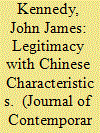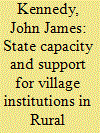|
|
|
Sort Order |
|
|
|
Items / Page
|
|
|
|
|
|
|
| Srl | Item |
| 1 |
ID:
149748


|
|
|
|
|
| Summary/Abstract |
In 2010, according to the sixth Chinese census, the sex ratio at birth (SRB) was 118 males for every 100 females. The global SRB average is about 105. Thus, the gap between 118 and 105 is made up of “missing girls.” Scholars present three main explanations for the skewed SRB statistic: sex-selective abortion, infanticide and delayed or late registration. Most studies take a demographic and cultural approach to explain the high SRB. However, we believe the story of the “missing girls” is also an administrative one and adopt the street-level bureaucrat theory of policy implementation to explain the pervasiveness of late registration in rural China. We use descriptive statistics derived from the 1990, 2000 and 2010 census data to identify the “missing girls.” We believe the combination of late registration and unreported births may point to a larger proportion of “missing girls” than previously reported from the SRB statistic.
|
|
|
|
|
|
|
|
|
|
|
|
|
|
|
|
| 2 |
ID:
076464


|
|
|
| 3 |
ID:
088456


|
|
|
|
|
| Publication |
2009.
|
| Summary/Abstract |
Over the last 20 years, an increasing number of villagers have experienced free and fair elections, and this has contributed to the legitimacy of local democratic practices as well as the authoritarian regime. Yet, these improvements in election procedures can only occur when township officials are removed from the village leader selection process. As a result, the increase in regime legitimacy is closely tied to reduction in the authority of mid-level officials to directly select subordinates. This process, where it has occurred, has generated a bottom-up institutionalization of democratic practices, and suggests that researchers should not dismiss the importance of election procedures too quickly.
|
|
|
|
|
|
|
|
|
|
|
|
|
|
|
|
| 4 |
ID:
158657


|
|
|
|
|
| Summary/Abstract |
While mass mobilization and political campaigns were the main administrative tools for policy implementation in China during the Maoist era (1949–1976), they continued to a lesser extent into the reform period. In the Maoist era, these campaigns shaped the social and economic life of residents and government officials. However, the use of campaigns and mass mobilization diminished in the 1980s and 1990s in favor of modern administrative procedures. Instead, narrower mobilization of cadres and campaign-style policy pushes became part of the available administrative tools for policy implementation. The Chinese Communist Party (CCP) sometimes reverts to campaign-style methods to deal with uneven implementation and local government foot dragging. The use of policy pushes suggests an elastic form of implementation where an intense wave of central leadership policy commitment can stretch down to the local level for a short period of time and then it recedes. Looking at the single child policy (birth control measures) from the 1980s to the early 2000s, and several environmental policies such as ‘blue sky’ days, the authors demonstrate that the CCP still relies on campaign-style policy pushes as one of the administrative tools for policy implementation.
|
|
|
|
|
|
|
|
|
|
|
|
|
|
|
|
| 5 |
ID:
092872


|
|
|
|
|
| Publication |
2009.
|
| Summary/Abstract |
For successful political reforms, such as village elections or elimination of arbitrary fees, the central party-government must have the political capacity to implement new laws down to the village level. Thus for researchers as well as government officials, it is important to have accurate measures of reform success or failure. There are two equally important measures that are closely tied to state capacity. One measure is the top-down level of commitment that county and township officials have towards implementing reforms. That is, whether these new institutions exist and function at the village level. The second measure is the bottom-up villager evaluation of local institutional procedures and cadre behavior. Using data collected in one northwest province in 2000 and 2004, findings show that implementation of some reforms, such as village elections, is uneven, while other reforms, such as the 2002 tax-fee reforms, were more successful. There are two implications from this study. One is that the central party-government lacks the commitment rather than the capacity to fully implement village elections. The urgency of relieving villagers' tax-fee burdens that were perceived as the source of rural unrest and instability was more important than the development of village elections. Second, in villages where the reforms are fully implemented, villagers make a clear conceptual distinction between popular support for the elected leaders and the election process. That is, they display disgust for the elected leaders and support for the election process and the village fee system. However, in villages where reforms are not fully carried out, villagers exhibit a more uniform lack of support for leaders and local institutions.
|
|
|
|
|
|
|
|
|
|
|
|
|
|
|
|
|
|
|
|
|